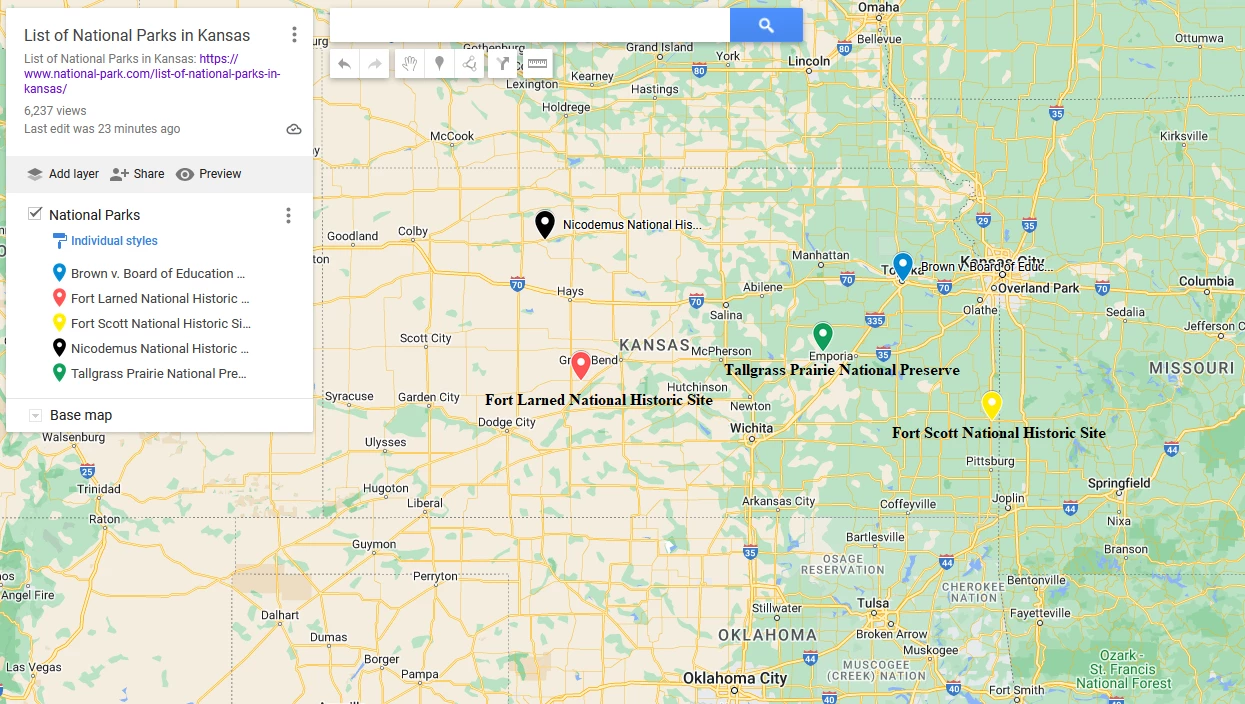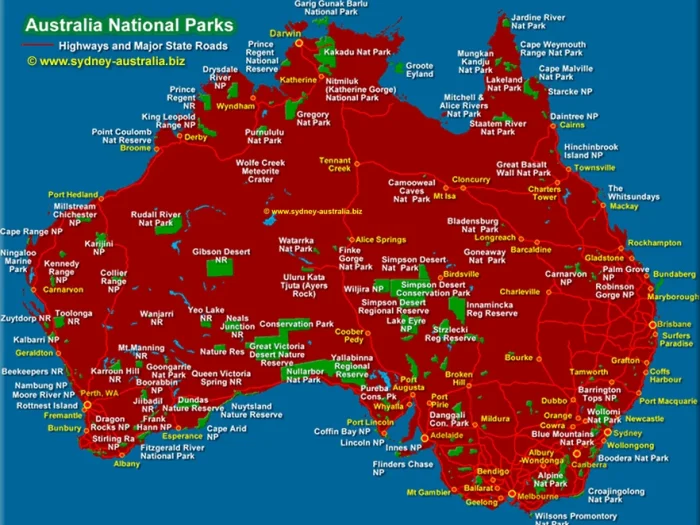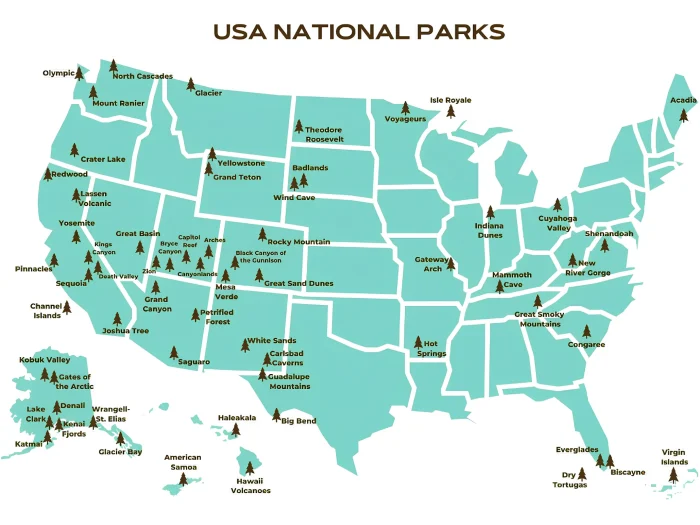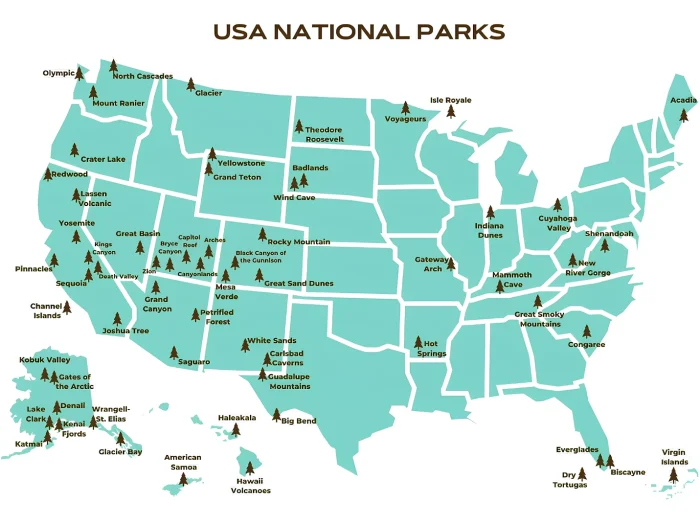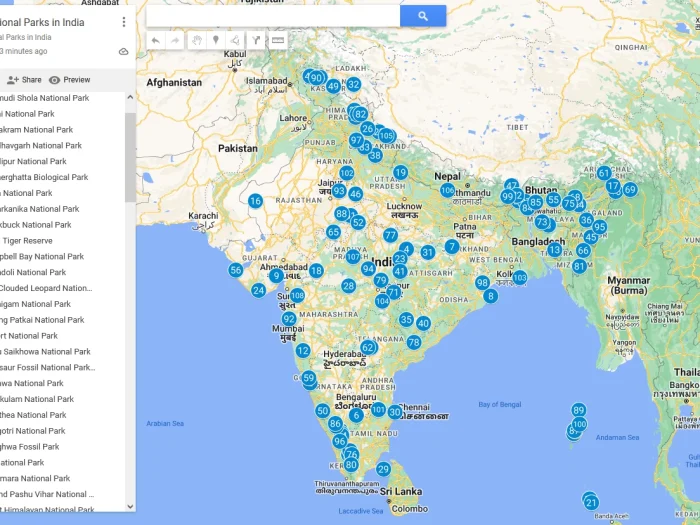List of National Parks in Kansas
Kansas has 5 National Parks:
- Brown v. Board of Education National Historical Park
- Fort Larned National Historic Site
- Fort Scott National Historic Site
- Nicodemus National Historic Site
- Tallgrass Prairie National Preserve
In this article I will write about these parks (infomation, things to do, weather). I also add Kansas National Parks map at the end of the article.
List of National Parks in Kansas
(You can click the image below to see Kansas National Parks map in full size)
1. Brown v. Board of Education National Historical Park
The Brown v. Board of Education National Historical Park commemorates the landmark Supreme Court decision that declared state laws establishing separate public schools for black and white students unconstitutional. The park is located in Topeka, Kansas, United States. Specifically, it encompasses the Monroe Elementary School, one of the segregated schools involved in the Brown v. Board of Education case.
Information:
- Address: 1515 SE Monroe St, Topeka, KS 66612, United States
- Established: 1992
- Official website: https://www.nps.gov/brvb/index.htm
- Phone: +1 785-354-4273
Things to do:
- Visitor Center: The park has a visitor center where you can learn about the history of the case, the people involved, and the impact it had on the civil rights movement.
- Guided Tours: Guided tours of Monroe Elementary School are available, providing insight into the experiences of students during the era of segregation and the significance of the case.
- Exhibits: There are exhibits showcasing artifacts, photographs, and documents related to the Brown v. Board of Education case and the civil rights movement.
- Educational Programs: The park offers educational programs for visitors of all ages, including school groups, to learn about civil rights history and the importance of equality.
- Outdoor Spaces: The park also has outdoor spaces where visitors can reflect on the significance of the case and its impact on American society.
Weather:
- Summer (June to August), temperatures can range from the 70s to the 90s Fahrenheit (around 21 to 35 degrees Celsius).
- Winters (December to February) can be cold, with temperatures often dropping below freezing, ranging from the 20s to 40s Fahrenheit (around -7 to 4 degrees Celsius).
- Spring and fall are generally mild, with temperatures in the 50s to 70s Fahrenheit (around 10 to 25 degrees Celsius).
2. Fort Larned National Historic Site
Fort Larned National Historic Site is located in central Kansas, United States, near the town of Larned. It’s situated along the historic Santa Fe Trail, a major trade route in the 19th century.
Information:
- Address: 1767 KS-156, Larned, KS 67550, United States
- Established: August 31, 1964
- Size: 2.906 km²
- Official website: https://www.nps.gov/fols/index.htm
- Phone: +1 620-285-6911
Things to do at Fort Larned National Historic Site:
- Visitor Center: The site features a visitor center where you can learn about the history of Fort Larned, its role in westward expansion, and the daily life of soldiers and civilians stationed there.
- Guided Tours: Guided tours of the fort are available, led by knowledgeable park rangers who provide insights into the fort’s history, architecture, and significance.
- Living History Demonstrations: Periodic living history demonstrations bring the fort to life, with reenactors portraying soldiers, officers, and civilians, showcasing activities such as military drills, cooking, and crafts.
- Self-Guided Exploration: Visitors can explore the fort’s restored buildings, including officer quarters, barracks, the commissary, and the blacksmith shop, at their own pace.
- Hiking Trails: The site offers hiking trails that allow visitors to explore the surrounding prairie landscape and appreciate the natural beauty of the area.
Weather of Fort Larned National Historic Site
- Summer: Summers (June to August) tend to be hot and humid, with temperatures often reaching the 80s and 90s Fahrenheit (around 27 to 37 degrees Celsius).
- Winter: Winters (December to February) are cold, with temperatures frequently dropping below freezing, ranging from the 20s to 40s Fahrenheit (around -7 to 4 degrees Celsius).
- Spring and Fall: Spring and fall are transitional seasons with milder temperatures, ranging from the 50s to 70s Fahrenheit (around 10 to 25 degrees Celsius). It’s advisable to check the weather forecast before visiting and to dress accordingly, especially if you plan to spend time outdoors exploring the fort and its surroundings.
3. Fort Scott National Historic Site
Fort Scott National Historic Site is located in southeastern Kansas, United States, near the town of Fort Scott. It’s situated along the historic Fort Scott Road and served as a key military outpost on the frontier during the 19th century.
Information:
- Address: 199 Old Fort Blvd, Fort Scott, KS 66701, United States
- Established: October 19, 1978
- Size: 7 ha
- Official website: https://www.nps.gov/fosc/index.htm
- Phone: +1 620-223-0310
Things to do:
- Visitor Center: The site features a visitor center where you can learn about the history of Fort Scott, its strategic importance, and the daily lives of soldiers and civilians who lived there.
- Guided Tours: Guided tours of the fort are available, led by knowledgeable park rangers who provide insights into the fort’s history, architecture, and significance. The tours often include visits to restored buildings such as barracks, officer quarters, the hospital, and the quartermaster’s storehouse.
- Living History Demonstrations: Periodic living history demonstrations bring the fort to life, with reenactors portraying soldiers, officers, and civilians engaged in activities such as military drills, cooking, blacksmithing, and woodworking.
- Self-Guided Exploration: Visitors can explore the fort’s grounds and restored buildings at their own pace, using interpretive signs and exhibits to learn about various aspects of frontier life and military operations.
- Hiking Trails: The site offers hiking trails that allow visitors to explore the surrounding prairie landscape and appreciate the natural beauty of the area.
Weather
- Summer: Summers (June to August) tend to be hot and humid, with temperatures often reaching the 80s and 90s Fahrenheit (around 27 to 37 degrees Celsius).
- Winter: Winters (December to February) are cold, with temperatures frequently dropping below freezing, ranging from the 20s to 40s Fahrenheit (around -7 to 4 degrees Celsius).
- Spring and Fall: Spring and fall are transitional seasons with milder temperatures, ranging from the 50s to 70s Fahrenheit (around 10 to 25 degrees Celsius).
4. Nicodemus National Historic Site
Nicodemus National Historic Site is located in northwest Kansas, United States, near the town of Nicodemus. It’s situated in the High Plains region and is one of the few remaining African American settlements established during the Reconstruction era.
Information:
- Address: 304 Washington Ave, Bogue, KS 67625, United States
- Established: November 12, 1996
- Official website: https://www.nps.gov/nico/index.htm
- Phone: +1 785-839-4233
Things to do:
- Visitor Center: The site features a visitor center where you can learn about the history of Nicodemus, the experiences of its founders, and the contributions of African Americans to the development of the American West.
- Guided Tours: Guided tours of the historic site are available, led by park rangers or local volunteers who provide insights into the town’s history, architecture, and significance. The tours often include visits to historic buildings, churches, and other landmarks associated with the settlement.
- Interpretive Exhibits: The visitor center and other facilities contain interpretive exhibits, artifacts, photographs, and documents that illustrate the story of Nicodemus and its role in African American history and western expansion.
- Cultural Events: Nicodemus National Historic Site hosts cultural events, programs, and festivals throughout the year, celebrating the heritage and traditions of the Nicodemus community and African American culture.
- Self-Guided Exploration: Visitors can explore the historic site at their own pace, walking through the town and reflecting on its significance in American history and the struggle for civil rights.
Weather:
- Summer: Summers (June to August) tend to be warm, with temperatures often reaching the 80s and 90s Fahrenheit (around 27 to 37 degrees Celsius).
- Winter: Winters (December to February) are cold, with temperatures frequently dropping below freezing, ranging from the 20s to 40s Fahrenheit (around -7 to 4 degrees Celsius).
- Spring and Fall: Spring and fall are transitional seasons with milder temperatures, ranging from the 40s to 70s Fahrenheit (around 4 to 25 degrees Celsius).
5. Tallgrass Prairie National Preserve
Tallgrass Prairie National Preserve is located in the Flint Hills region of east-central Kansas, United States, near the town of Strong City. It covers a vast area of rolling hills and expansive grasslands, preserving a significant portion of the tallgrass prairie ecosystem.
Information:
- Address: 2480B KS Hwy 177, Strong City, KS 66869, United States
- Established: November 12, 1996
- Official website: https://www.nps.gov/tapr/index.htm
- Phone: +1 620-273-8494
Things to do:
- Visitor Center: The preserve features a visitor center where you can learn about the tallgrass prairie ecosystem, its flora and fauna, and the cultural history of the region. The center often hosts exhibits, films, and educational programs for visitors of all ages.
- Guided Tours: Guided tours of the preserve are available, led by knowledgeable park rangers or local naturalists who provide insights into the prairie ecosystem, its wildlife, and conservation efforts. The tours may include walks or tram rides through the prairie, allowing visitors to experience the landscape up close.
- Hiking Trails: The preserve offers hiking trails that allow visitors to explore the tallgrass prairie on foot, offering opportunities for birdwatching, wildlife observation, and photography. Some trails may lead to scenic overlooks or points of interest within the preserve.
- Bison Viewing: The preserve is home to a herd of American bison, and visitors may have the chance to see these iconic animals roaming the prairie. Bison viewing areas are available, providing opportunities for visitors to observe these majestic creatures in their natural habitat.
- Educational Programs: The preserve offers educational programs and workshops focused on topics such as prairie ecology, native plants, and wildlife conservation. These programs are designed to engage visitors and deepen their understanding of the tallgrass prairie ecosystem.
Weather
- Summer: Summers (June to August) tend to be warm, with temperatures often reaching the 80s and 90s Fahrenheit (around 27 to 37 degrees Celsius). Thunderstorms are common during the summer months.
- Winter: Winters (December to February) are cold, with temperatures frequently dropping below freezing, ranging from the 20s to 40s Fahrenheit (around -7 to 4 degrees Celsius). Snowfall is possible during the winter months.
- Spring and Fall: Spring and fall are transitional seasons with milder temperatures, ranging from the 40s to 70s Fahrenheit (around 4 to 25 degrees Celsius). These seasons are often considered the best times to visit the preserve, as the weather is generally pleasant and wildflowers may be in bloom.
Kansas National Parks map
Now you can answer the question: “how many national parks in kansas?” It has 5 national parks.
Tag: kansas national parks, national parks in kansas, national parks near kansas
Read more:

